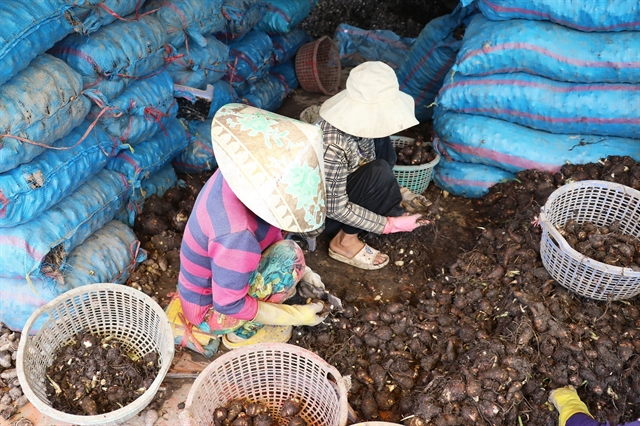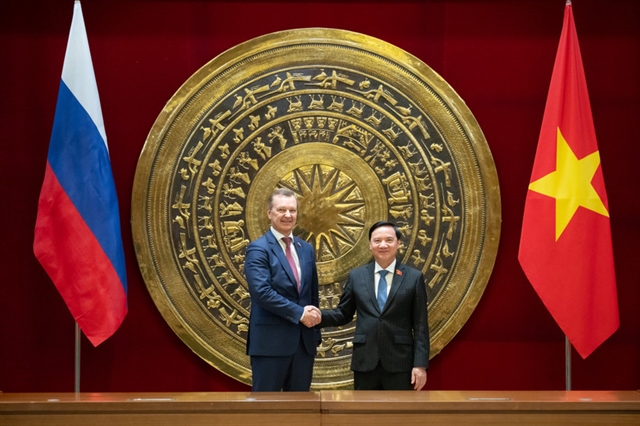 Society
Society

 |
| After harvest, taro has its roots trimmed and is sorted before being sold in the market. . – VNA/VNS Photo Hữu Chí |
ĐỒNG THÁP – Many farmers in Đồng Tháp Province’s Mỹ An Hưng Commune have tied their livelihoods to taro, earning stable incomes and improving their quality of life.
Local authorities have identified taro as a key agricultural product for focused development. The commune has more than 5,000ha of farmlands, of which 1,000ha are used for taro cultivation.
Of the latter, 108ha are certified as meeting Vietnamese Good Agricultural Practices standards, while another 100ha are grown to safe production standards. The commune has two co-operatives and two farmers’ community clubs specialising in taro, with their 140 members collectively farming 327ha.
Taro can be grown year round, with each crop cycle lasting three to four months.
Most farmers grow two main crops annually – winter–spring, which yields 15–17 tonnes per hectare, and summer–autumn, which yields 12–13 tonnes.
After harvesting taro, farmers often grow vegetables or a rice crop to maximise land use and increase incomes.
To add value, many now adopt new farming techniques, pay closer attention to soil care and prioritise safe and organic production methods.
Dương Văn Kiệp, a farmer with more than 20 years of experience, said: “To improve crop value, I select high-quality taro bulbs for planting, apply proper cultivation techniques, and manage pests effectively.
“Most importantly, I follow planting schedules and apply organic fertilisers. Using organic fertilisers has helped cut production costs by 30–40 per cent.”
Traders currently buy taro directly at the farm gate for VNĐ12,000–13,000 (45–49 US cents) per kilo, which means farmers regularly earn profits of VNĐ70–150 million (US$2,660–5,700) per hectare per crop.
Nguyễn Thanh Phó, head of the Tân Hưng farmers’ community club, said 86 members cultivated 250ha of taro.
“Members hold monthly meetings to share new techniques in seedling propagation and cultivation. Thanks to this knowledge exchange, our members’ fields consistently achieve high yields.”
Taro farming also creates seasonal jobs every year.
Harvesting, post-harvest handling and seedling production provide extra income opportunities for local people, who earn VNĐ100,000–200,000 ($3.8–7.6) a day.
Nguyễn Dung Thạch, deputy chairman of the commune People’s Committee, said taro had been chosen as one of six priority crops in the province’s agricultural restructuring plan.
Several support measures had been launched, including upgrading irrigation and transport infrastructure and converting inefficient rice fields into higher-value crops like taro.
The commune encouraged farmers to adopt advanced cultivation and harvesting techniques to improve productivity and quality while ensuring food safety.
Local authorities were also helping strengthen linkages between farmers and businesses for sales and processing.
Lê Hồng Nghi, owner of taro trading establishment Công Nghi, said: “Each crop season I work with traders from other provinces and go directly to the growing areas to buy taro.
“These linkages allow farmers to expand their production areas, invest with confidence, and avoid price drops. They also help build a more sustainable value chain.”
The commune People’s Committee created conditions for businesses, co-operatives, farmers’ community clubs, and individuals with growing area codes to meet, exchange information, and cooperate to develop production areas and market linkages, especially for taro.
To further raise the value of taro, the commune was upgrading irrigation systems and building dykes that also serve as roads, helping protect farms and improve transport.
Thạch added: “In the coming time we will focus on supporting farmers in marketing and processing key farm products.
“We will continue to provide training in production processes, particularly safe standards, to ensure food safety and meet market demand.
“At the same time we will promote products grown in large quantities in both domestic and overseas markets to secure stable outlets.” – VNS




